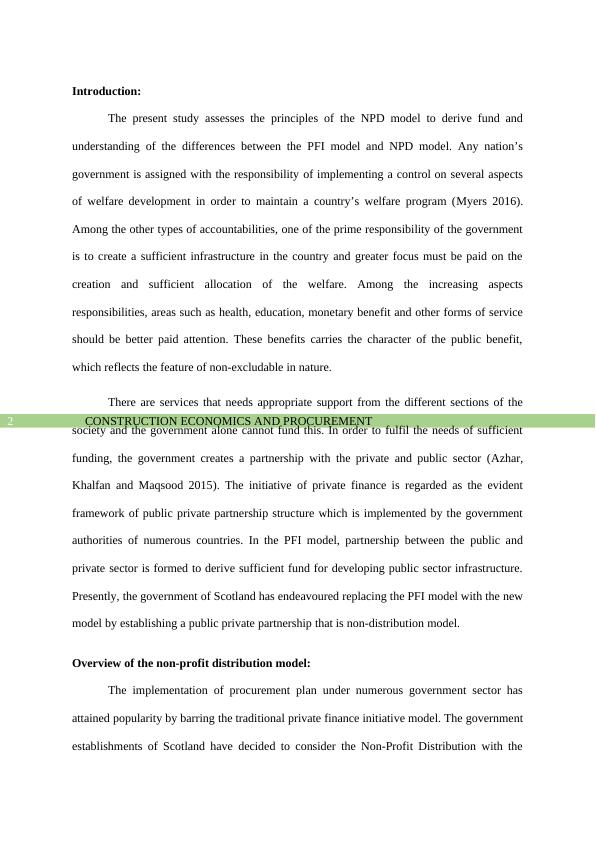Construction Economics and Procurement Assignment
Added on 2020-04-15
11 Pages2826 Words60 Views
Running head: CONSTRUCTION ECONOMICS AND PROCUREMENTConstruction Economics and ProcurementName of the StudentName of the UniversityAuthors NoteCourse ID

CONSTRUCTION ECONOMICS AND PROCUREMENT1Table of ContentsIntroduction:...............................................................................................................................3Overview of the non-profit distribution model:.........................................................................3Principles involved in the NPD model of Scotland:..................................................................4Difference between PFI and NPD model of fund procurement:................................................4Critical evaluation of the NPD projects: Scotland Construction Industry.................................5Factors leading to success of NPD project:................................................................................5Factors leading to negative impact on the NPD Model:............................................................7Scope for improving the NPD model:........................................................................................8Conclusion:................................................................................................................................9

CONSTRUCTION ECONOMICS AND PROCUREMENT2Introduction: The present study assesses the principles of the NPD model to derive fund andunderstanding of the differences between the PFI model and NPD model. Any nation’sgovernment is assigned with the responsibility of implementing a control on several aspectsof welfare development in order to maintain a country’s welfare program (Myers 2016).Among the other types of accountabilities, one of the prime responsibility of the governmentis to create a sufficient infrastructure in the country and greater focus must be paid on thecreation and sufficient allocation of the welfare. Among the increasing aspectsresponsibilities, areas such as health, education, monetary benefit and other forms of serviceshould be better paid attention. These benefits carries the character of the public benefit,which reflects the feature of non-excludable in nature. There are services that needs appropriate support from the different sections of thesociety and the government alone cannot fund this. In order to fulfil the needs of sufficientfunding, the government creates a partnership with the private and public sector (Azhar,Khalfan and Maqsood 2015). The initiative of private finance is regarded as the evidentframework of public private partnership structure which is implemented by the governmentauthorities of numerous countries. In the PFI model, partnership between the public andprivate sector is formed to derive sufficient fund for developing public sector infrastructure.Presently, the government of Scotland has endeavoured replacing the PFI model with the newmodel by establishing a public private partnership that is non-distribution model. Overview of the non-profit distribution model: The implementation of procurement plan under numerous government sector hasattained popularity by barring the traditional private finance initiative model. The governmentestablishments of Scotland have decided to consider the Non-Profit Distribution with the

CONSTRUCTION ECONOMICS AND PROCUREMENT3objective of obtaining fund for infrastructural development of the public sector from theinvestment made by the private sector (Hosseini et al. 2013). The government authoritieshave implemented the NPD model in several sectors namely education and welfare andwished-for deriving fund to develop the transport segment of the country. Principles involved in the NPD model of Scotland: The Scotland government implements the model of NPD, which is presentlydependent on the principles of procuring the funds for the infrastructure development of thepublic sector for efficient project distribution (Finkel 2015). There are three vital principlesthat are involved in determining the model of NPD for procuring fund in Scotland; a.There must be an inclusive involvement of the private sector stakeholders formanaging the projects of public sector involving infrastructural expansion togetherwith several welfare development plan namely education and health. b.The benefits derived from the investment of the private sector is not based on theequity base dividend. It represents that the stakeholders does not becomes the portionof the risk and return of investment (Zavadskas, Turskis and Kildienė 2014). Differentfrom the pre-planned amount from the amount that is invested the scheme oftraditional investment assist in deriving fund for the public sector projects. c.The return generated from the investment derived by the private sector in the publicsector projects are covered up to the particular limit. Similar to the dividend equitysystem, the investors involved in the public sector would be obtaining pre-plannedsum which is obtainable under the traditional procurement system. Difference between PFI and NPD model of fund procurement: The NPD model is created and implemented by the government of Scotland that isdifferent from the model of PFI. The framework of NPD arising from the limitations faces

End of preview
Want to access all the pages? Upload your documents or become a member.
Related Documents
Construction Economics Assignmentlg...
|15
|3662
|246
Construction Economics and Procurement in Scotlandlg...
|11
|2702
|84
Reasons for Success of the NPD Model Projectslg...
|15
|3525
|103
Procurement & Contractslg...
|6
|811
|176
Role of the Private Sector in Sustainable Developmentlg...
|5
|583
|85
Contracts and Procurement Management Assignmentlg...
|13
|4017
|57
